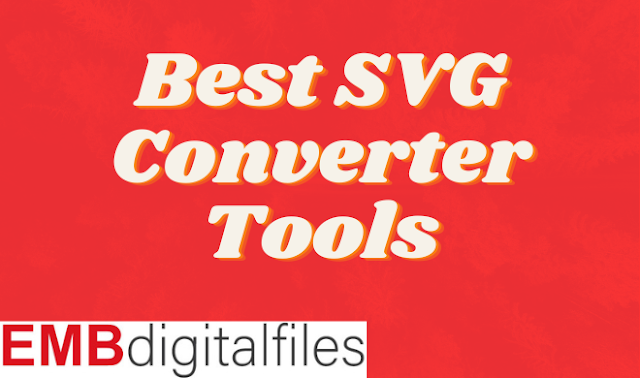- Introduction
to SVG Converter Tools
- Understanding
SVG File Format
- Importance
of SVG Converter Tools
- Factors
to Consider When Choosing the Best SVG Converter
- Compatibility
- Conversion
Options
- Ease
of Use
- Speed
and Performance
- Top
Features to Look for in SVG Converter Tools
- Batch
Conversion
- Customization
Options
- Output
Formats Supported
- Compression
Abilities
- Comparison
of Leading SVG Converter Tools
- How
to Use an SVG Converter Tool
- Step-by-Step
Guide
- Tips
for Maximizing the Benefits of SVG Converter Tools
- Common
Mistakes to Avoid When Using SVG Converters
- Future
Trends in SVG Conversion Technology
- Case
Studies: Real-Life Applications of SVG Converter Tools
- Conclusion
- FAQs
Introduction: Understanding SVG Converter
Tools
In the digital
world, where visuals play a pivotal role in communication, Scalable Vector
Graphics (SVG) have emerged as a versatile format for creating and displaying
images. However, the need often arises to convert SVG files into other
formats or optimize them for various purposes. This is where SVG
converter tools come into play.
Understanding SVG File Format
SVG, as a file format, is based on XML and is designed
for describing two-dimensional vector graphics. Unlike raster image
formats like JPEG or PNG, SVG images are resolution-independent, meaning
they can be scaled to any size without losing quality. This makes them ideal
for use on websites, mobile apps, and other digital
platforms.
Importance of SVG Converter Tools
SVG converter tools serve multiple purposes, catering to
the diverse needs of designers, developers, and content creators. Whether it's
converting SVG
files to PNG for better browser compatibility or compressing them to
improve website performance, these tools streamline the workflow and enhance
productivity.
Factors to Consider When Choosing the Best
SVG Converter
When selecting an SVG
converter tool, several factors should be taken into account to ensure
optimal performance and user experience. These include compatibility with
different platforms, available conversion options, ease of use, and speed.
Top Features to Look for in SVG Converter
Tools
The best SVG converter tools offer a range of features
to meet the varying needs of users. These include batch conversion
capabilities, customization
options such as color adjustment and cropping, support for multiple output
formats, and advanced compression algorithms to reduce file size without
compromising quality.
Comparison of Leading SVG Converter Tools
To help users make an informed decision, it's essential
to compare the top SVG converter tools
available in the market. Each tool has its unique strengths and weaknesses, and
evaluating them based on criteria such as price, performance, and user reviews
can aid in selecting the most suitable option.
How to Use an SVG Converter Tool
Using an SVG converter tool is typically
straightforward, but a step-by-step guide can help beginners
navigate the process with ease. From uploading the SVG file to selecting the
desired output format and adjusting conversion
settings, clear instructions ensure a seamless experience.
Tips for Maximizing the Benefits of SVG Converter
Tools
To make the most out of SVG converter tools, users can
follow a few tips
and tricks to optimize their workflow and achieve better results. These
include organizing files efficiently, experimenting with different settings,
and staying updated on new features and enhancements.
Common Mistakes to Avoid When Using SVG
Converters
Despite their usefulness, SVG converter tools can
sometimes lead to errors or undesirable outcomes if not used correctly. By
being aware of common mistakes such as choosing the wrong output format or
neglecting to check for compatibility
issues, users can avoid unnecessary frustration and setbacks.
Future Trends in SVG Conversion Technology
As technology continues to evolve, so too will SVG
conversion tools, with advancements in automation, machine learning, and artificial
intelligence driving innovation in this space. Predicting future trends can
help users stay ahead of the curve and harness the full potential of SVG
conversion technology.
Conclusion
In conclusion, SVG converter tools play a crucial role
in modern digital
workflows, offering a convenient solution for converting, optimizing, and
manipulating SVG files. By understanding the key
features, comparing different options, and following best practices, users
can harness the power of these tools to enhance their creative projects and
streamline their processes.
FAQs:
- What
is an SVG converter tool?
An SVG converter tool is a
software application or online service that allows users to convert Scalable
Vector Graphics (SVG)
files into other formats, such as PNG, JPEG, or PDF. These tools are commonly
used by designers, developers, and content creators
to optimize and manipulate SVG
images for various purposes.
- How
does an SVG converter tool work?
SVG
converter tools work by parsing the XML code of the SVG file and converting
it into a raster image format, such as PNG or JPEG, or another vector format,
such as PDF or EPS. This conversion process may involve scaling, cropping, or
applying other transformations to the original SVG
file based on user preferences or predefined settings.
- Are
SVG converter tools free to use?
While there are some free
SVG converter tools available, many advanced or feature-rich
tools may require a purchase or subscription fee. Free tools often have
limitations on conversion options, file
size, or output quality.
- Can
SVG converter tools convert files in bulk?
Yes, many SVG converter
tools offer batch conversion capabilities, allowing users to convert
multiple SVG files simultaneously. This feature
is particularly useful for users
who need to process large numbers of SVG files quickly and efficiently.
- What
are the common output formats supported by SVG converter tools?
The common output
formats supported by SVG converter tools include PNG, JPEG, PDF, EPS, and SVG
itself. Additionally, some tools may support specialized formats for
specific use cases, such as web optimization (e.g., WebP) or print
production (e.g., TIFF).
If you’re looking to
digitize your personalized embroidery design or
convert them into vector art, it’s best to rely on
professionals like embdigitalfiles.com.
Digitizing and vector art conversion are complex processes that require
expertise and experience.








0 Comments